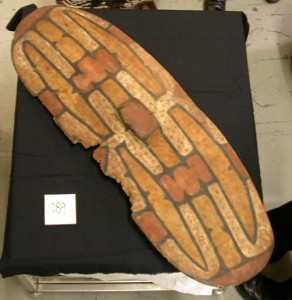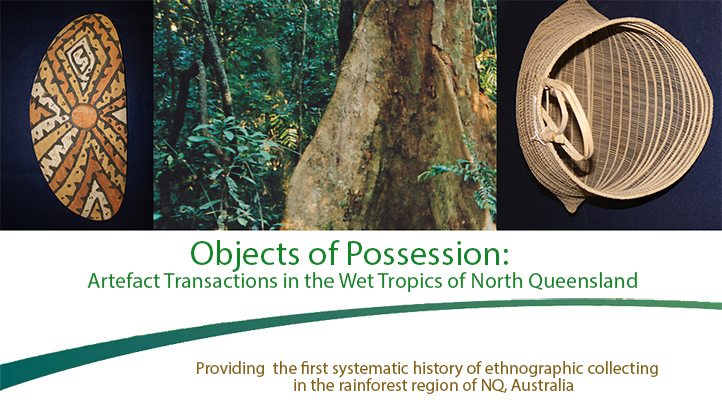Author: Trish Barnard
Collector: Joseph Campbell
Born: St Marys, New South Wales, 1856.
Died: Barmedman, New South Wales, 1933.
Active: Campbell collected in the Ingham, Wrights Creek and Yarrabah areas from 1910 to 1916.
Background biography: Joseph Campbell arrived in Cairns as an archdeacon in 1903, after serving in various clerical positions in New South Wales and New Zealand for more than twenty years. In 1909 he resigned from the church to pursue his agricultural interests and travelled overseas to research cotton-growing. Campbell returned to North Queensland in 1910 and as Director of Cotton Culture he established Gossypium Park Estates Ltd. at Wrights Creek south of Cairns. He employed and supervised local Aboriginal labour at the cotton plantation and had access to collecting their material culture. A few years later, in 1915, the plantation went into receivership after a drought and one of the cotton gins was sent to Yarrabah. The following year, he sold his collection of artefacts, including shields, baskets and spears, to the Queensland Museum for 30 pounds (28 September 1916 – QE1006-QE4186). He had negotiated the sale with the the Museum’s Director, Ronald Hamlyn-Harris. Many collectors around this time were responding to an appeal from Hamlyn-Harris to acquire more Aboriginal material for the state collection. Campbell’s collection contributed more than 2,800 items to the Queensland Museum over the following seven years. It comprised material from across Queensland including the Wet Tropics.
Included in his collection were the unique bicornual baskets made from the fibre of lawyer cane (Calamus caryotoides), a large, prickly climbing palm, twined together to produce the distinct crescent shape. The baskets in his collection were plain (without the use of dye in the preparation of the fibre) and had no coloured decoration painted on the surface, which was the custom for ceremonial or sacred purposes. Smaller baskets were used to carry seeds and fruit, and placed into the running water to leach toxins from seeds. The larger ones were used to carry babies and possessions, and the long handles attached to the bicornual baskets were placed across the forehead with the basket against the persons back, allowing the hands to remain free. One particular bicornual basket still has remnants of cotton seeds inside, evidence that these baskets were well suited for picking cotton in the Gossypium Park fields.
Other interesting artefacts from his collection now at the Queensland Museum, are two shields decorated on the surface with the ‘bark canoe’ design (QE-1089, QE-1150). This design is also similar to a shield held in the in the British Museum (Oc.1933.0403.3). Contemporary artist Michael Boiyool Anning (1955-) continues the tradition of decorating shields in traditional Yidinji designs that represent both animal and plant totems of importance. His ‘Bark Canoes’ shield is held in the Queensland Art Gallery of Modern Art collection (2004.163). Another shield depicts a ‘hand held fish net’ design (QE-1142), similar to other shields held in E013435 in the Australian Museum (E013435) and the Rautenstrauch-Joest Museum in Germany (22096). A contemporary version also made by Anning in 2011 is held in the Queensland Museum collection (QE-40655). In traditional times, the shields were cut from the buttress roots of native fig trees which, being softwood, were easily carved into an asymmetric shape. After shaping the shields, two men would paint them with rich ochre colours using culturally significant designs associated with the young initiate or his clan group.
Collections such as Campbell’s continue to be a valuable resource for contemporary artists visiting museums to survey traditional material culture and designs associated with their cultural group. In the Wet Tropics of North Queensland, ‘Bama’ is the common language word for Aboriginal people from the rainforest regions. Yidinji man Anning from Ravenshoe and Djabugay man Napoleon Oui from Cairns have both visited museums to learn more about designs they can use with approval from Elders. One shield in Campbell’s collection depicts Bama (QE-1127) and this has been reinterpreted by both artists – one shield at the Queensland Art Gallery of Modern Art titled ‘Bama – The people’ by Anning (2004.162) and screen prints on paper and canvas by Oui sold though his website or at the annual Cairns Indigenous Art Fair.

QE-1089 Shield, collected from Wrights Creek near Edmonton, North Queensland. Design represents ‘bark canoes’. Queensland Museum collection. Photo: Trish Barnard.
Campbell’s collection represents an important assemblage of artefacts produced primarily by people employed at his cotton plantation, which at that time was one of the first enterprises to provide skills-development for Aboriginal people in the Wet Tropics. After some years working on other business interests, Campbell returned to the church in 1926, relieving in various clerical positions throughout southern New South Wales before he died in 1933.
Sources:
D. F. Branagan, ‘Campbell, Joseph (1856–1933)’, Australian Dictionary of Biography, National Centre of Biography, Australian National University, http://adb.anu.edu.au/biography/campbell-joseph-12838/text23175.
Mather, Patricia, et al., eds, (1986) ‘A Time for a Museum: The History of the Queensland Museum 1862-1986’, Memoirs of the Queensland Museum, Vol. 24.
